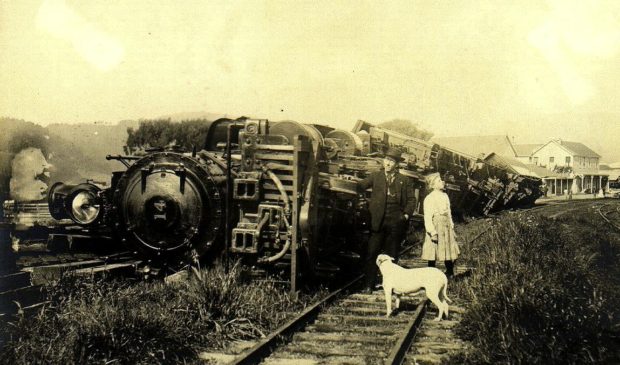Lonesome whistle blows for Lone Star Rail
Wednesday, June 8, 2016 by
Caleb Pritchard An ailing effort to run passenger rail from the Austin area to San Antonio might only have two months left to live.
On Monday night, the head of the Capital Area Metropolitan Planning Organization’s Transportation Policy Board suggested that he would soon seek to take formal steps that would essentially shut down the Lone Star Rail District, or LSTAR. Chairman Will Conley explained that pulling the plug on LSTAR is counterintuitively an essential step toward preserving the dream of passenger rail service along the Interstate 35 corridor.
“Sometimes you have to burn it down to save it,” Conley told the board.
His remarks came during a lengthy discussion among board members about recent efforts to salvage LSTAR after the district suffered a critical blow at the hands of Union Pacific earlier this year.
In February, Union Pacific pulled out of its longtime partnership with LSTAR to explore running passenger trains on the company’s existing rail line between Georgetown and San Antonio. That rail line was the primary focus of LSTAR’s federally mandated environmental impact study, its last major hurdle before construction could begin. LSTAR pledged to carry on by looking at alternative routes, but last month Conley sent a letter to Texas Department of Transportation Deputy Executive Director Marc Williams that suggested those alternatives do not fit into CAMPO’s long-range transportation plans, thus “effectively concluding the on-going environmental study efforts of” LSTAR.
Conley began Monday night’s discussion by highlighting Williams’ response to him in a letter dated June 3. Williams said that both CAMPO and its San Antonio counterpart, the Alamo Area Metropolitan Planning Organization (AAMPO), should remove LSTAR from their respective long-range plans if the alternatives aren’t compatible.
“The effective withdrawal of support of CAMPO and/or AAMPO would effectively terminate the (environmental impact study process),” Williams wrote. “From this point, the likely scenario is that (the Federal Highway Administration) could make a ‘no-build’ decision.”
Conley told the board that he would make a motion at the body’s Aug. 8 meeting to do just that. However, he insisted that the move wouldn’t spell the doom of rail planning, and he offered that CAMPO, AAMPO and TxDOT could work together to begin a new process.
Indeed, Williams ended his letter to Conley by affirming that “TxDOT would be happy to work with the regional MPOs in a planning assessment to address the future transportation needs between Austin and San Antonio.”
Travis County Judge Sarah Eckhardt said she was “buoyed” by that statement but feared that the no-build option might end up complicating matters so much that TxDOT could lose interest in supporting the effort.
“I think that we are all fairly sophisticated and we know prevarication when we see it,” Eckhardt said. “And I believe TxDOT needs cover from us. So what I’m trying to divine is what gives them maximum cover, and I fear that no-build doesn’t give them as much cover” as keeping the environmental study open in the hopes that UP might change its mind.
LSTAR Deputy Executive Director Joe Black implied to the board that Eckhardt’s optimism wasn’t without foundation. He noted that UP had in fact previously walked away from the project only to later return to it.
Several board members indicated that they would tolerate keeping Lone Star Rail’s efforts going, but only if AAMPO agreed to pick up the tab for the environmental study. Before the process began, CAMPO agreed to funnel into the study $20 million, which would be matched by a $20 million contribution from AAMPO for subsequent design work. So far, CAMPO has spent more than $11 million, while AAMPO hasn’t spent a penny.
“If San Antonio is not going to get in the game, then we look like chumps,” Travis County Commissioner Gerald Daugherty declared.
Conley offered to write a letter to AAMPO’s top brass to directly ask whether they would be interested in covering the remaining costs of the environmental study, which Black estimated to be as high as $3 million.
Travis County Commissioner Brigid Shea expressed concern that giving leadership of the project over to CAMPO or TxDOT might spell the end of rail as a viable option for improving transportation between the two cities. Pressing Conley, Shea said she wanted the conversation to be “realistic.”
“I cannot be any more realistic than I’m trying to be here,” Conley replied. “And I’m telling you the path that we’re currently on is a fantasy.”
Photo by G.K. Gilbert – Photographs from the U.S. Geological Survey Photographic Library. Federal Depository Library CD-ROM SuDoc No. I 19.121:8/CD, Public Domain, https://commons.wikimedia.org/w/index.php?curid=1215978
You're a community leader
And we’re honored you look to us for serious, in-depth news. You know a strong community needs local and dedicated watchdog reporting. We’re here for you and that won’t change. Now will you take the powerful next step and support our nonprofit news organization?






